MN502 T3 2018: Lightweight Cryptography in Network Security Overview
VerifiedAdded on 2023/04/21
|13
|2445
|329
Report
AI Summary
This report provides a comprehensive overview of lightweight cryptography, a crucial area of network security, particularly for low-power devices. It begins by defining lightweight cryptography, its goals, and its importance in securing modern applications like smart meters and wireless systems. The report then identifies and analyzes potential security threats in systems using low-power devices, such as bandwidth limitations, physical attacks, and inadequate resources. The working mechanism of lightweight cryptography, including encryption and decryption processes, is explained. Furthermore, the report delves into various lightweight cryptographic algorithms, including AES, DES, and ECC, comparing their key sizes, structures, and applications. The report also addresses current and future challenges in this field. Overall, the report highlights the significance of lightweight cryptography in enhancing security, especially in resource-constrained environments, and emphasizes its role in addressing emerging security threats. The report concludes by summarizing the key aspects discussed and their implications for the future of secure communication.

overview of network security
Paraphrase This Document
Need a fresh take? Get an instant paraphrase of this document with our AI Paraphraser

1 | P a g e
Table of Contents
Introduction about the lightweight cryptography...................................................................................1
Goal of light weighted cryptography.................................................................................................1
Potential security threats in systems using low-power devices..............................................................1
Working mechanism of lightweight cryptography.................................................................................2
Lightweight cryptographic algorithms...................................................................................................3
Current and Future challenges in lightweight cryptography..................................................................7
Conclusion.............................................................................................................................................8
References.............................................................................................................................................9
Table of Contents
Introduction about the lightweight cryptography...................................................................................1
Goal of light weighted cryptography.................................................................................................1
Potential security threats in systems using low-power devices..............................................................1
Working mechanism of lightweight cryptography.................................................................................2
Lightweight cryptographic algorithms...................................................................................................3
Current and Future challenges in lightweight cryptography..................................................................7
Conclusion.............................................................................................................................................8
References.............................................................................................................................................9
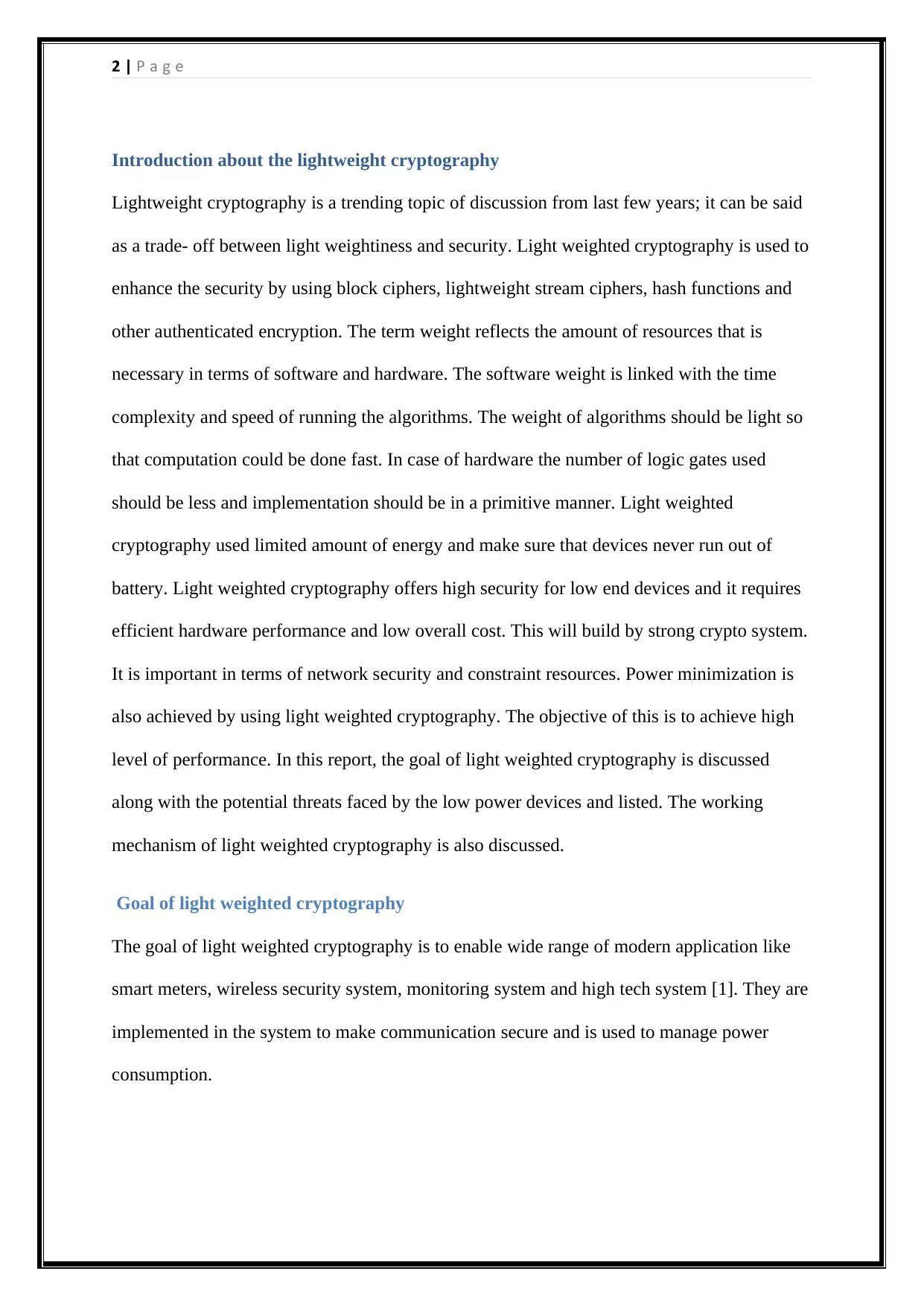
2 | P a g e
Introduction about the lightweight cryptography
Lightweight cryptography is a trending topic of discussion from last few years; it can be said
as a trade- off between light weightiness and security. Light weighted cryptography is used to
enhance the security by using block ciphers, lightweight stream ciphers, hash functions and
other authenticated encryption. The term weight reflects the amount of resources that is
necessary in terms of software and hardware. The software weight is linked with the time
complexity and speed of running the algorithms. The weight of algorithms should be light so
that computation could be done fast. In case of hardware the number of logic gates used
should be less and implementation should be in a primitive manner. Light weighted
cryptography used limited amount of energy and make sure that devices never run out of
battery. Light weighted cryptography offers high security for low end devices and it requires
efficient hardware performance and low overall cost. This will build by strong crypto system.
It is important in terms of network security and constraint resources. Power minimization is
also achieved by using light weighted cryptography. The objective of this is to achieve high
level of performance. In this report, the goal of light weighted cryptography is discussed
along with the potential threats faced by the low power devices and listed. The working
mechanism of light weighted cryptography is also discussed.
Goal of light weighted cryptography
The goal of light weighted cryptography is to enable wide range of modern application like
smart meters, wireless security system, monitoring system and high tech system [1]. They are
implemented in the system to make communication secure and is used to manage power
consumption.
Introduction about the lightweight cryptography
Lightweight cryptography is a trending topic of discussion from last few years; it can be said
as a trade- off between light weightiness and security. Light weighted cryptography is used to
enhance the security by using block ciphers, lightweight stream ciphers, hash functions and
other authenticated encryption. The term weight reflects the amount of resources that is
necessary in terms of software and hardware. The software weight is linked with the time
complexity and speed of running the algorithms. The weight of algorithms should be light so
that computation could be done fast. In case of hardware the number of logic gates used
should be less and implementation should be in a primitive manner. Light weighted
cryptography used limited amount of energy and make sure that devices never run out of
battery. Light weighted cryptography offers high security for low end devices and it requires
efficient hardware performance and low overall cost. This will build by strong crypto system.
It is important in terms of network security and constraint resources. Power minimization is
also achieved by using light weighted cryptography. The objective of this is to achieve high
level of performance. In this report, the goal of light weighted cryptography is discussed
along with the potential threats faced by the low power devices and listed. The working
mechanism of light weighted cryptography is also discussed.
Goal of light weighted cryptography
The goal of light weighted cryptography is to enable wide range of modern application like
smart meters, wireless security system, monitoring system and high tech system [1]. They are
implemented in the system to make communication secure and is used to manage power
consumption.
⊘ This is a preview!⊘
Do you want full access?
Subscribe today to unlock all pages.

Trusted by 1+ million students worldwide
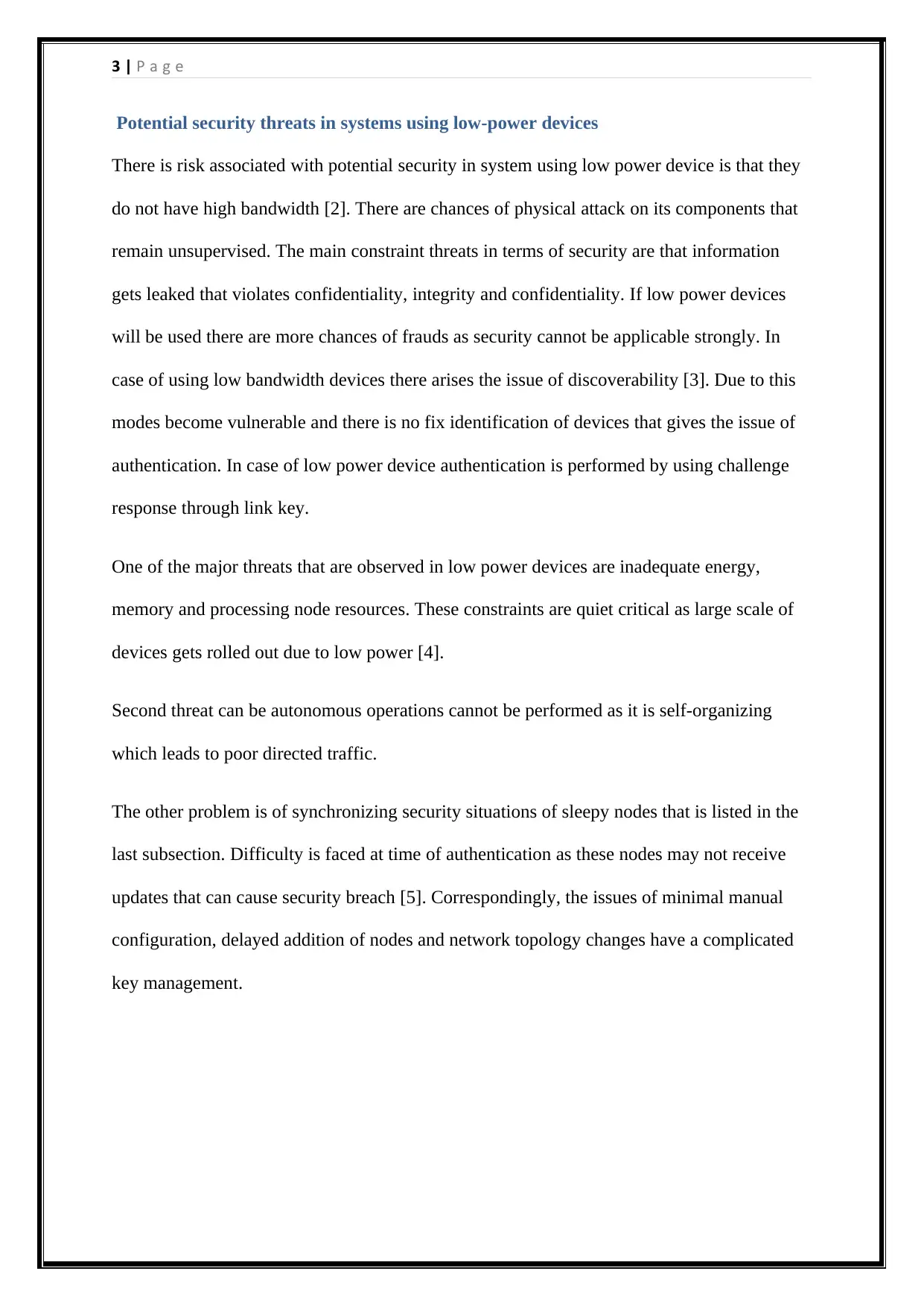
3 | P a g e
Potential security threats in systems using low-power devices
There is risk associated with potential security in system using low power device is that they
do not have high bandwidth [2]. There are chances of physical attack on its components that
remain unsupervised. The main constraint threats in terms of security are that information
gets leaked that violates confidentiality, integrity and confidentiality. If low power devices
will be used there are more chances of frauds as security cannot be applicable strongly. In
case of using low bandwidth devices there arises the issue of discoverability [3]. Due to this
modes become vulnerable and there is no fix identification of devices that gives the issue of
authentication. In case of low power device authentication is performed by using challenge
response through link key.
One of the major threats that are observed in low power devices are inadequate energy,
memory and processing node resources. These constraints are quiet critical as large scale of
devices gets rolled out due to low power [4].
Second threat can be autonomous operations cannot be performed as it is self-organizing
which leads to poor directed traffic.
The other problem is of synchronizing security situations of sleepy nodes that is listed in the
last subsection. Difficulty is faced at time of authentication as these nodes may not receive
updates that can cause security breach [5]. Correspondingly, the issues of minimal manual
configuration, delayed addition of nodes and network topology changes have a complicated
key management.
Potential security threats in systems using low-power devices
There is risk associated with potential security in system using low power device is that they
do not have high bandwidth [2]. There are chances of physical attack on its components that
remain unsupervised. The main constraint threats in terms of security are that information
gets leaked that violates confidentiality, integrity and confidentiality. If low power devices
will be used there are more chances of frauds as security cannot be applicable strongly. In
case of using low bandwidth devices there arises the issue of discoverability [3]. Due to this
modes become vulnerable and there is no fix identification of devices that gives the issue of
authentication. In case of low power device authentication is performed by using challenge
response through link key.
One of the major threats that are observed in low power devices are inadequate energy,
memory and processing node resources. These constraints are quiet critical as large scale of
devices gets rolled out due to low power [4].
Second threat can be autonomous operations cannot be performed as it is self-organizing
which leads to poor directed traffic.
The other problem is of synchronizing security situations of sleepy nodes that is listed in the
last subsection. Difficulty is faced at time of authentication as these nodes may not receive
updates that can cause security breach [5]. Correspondingly, the issues of minimal manual
configuration, delayed addition of nodes and network topology changes have a complicated
key management.
Paraphrase This Document
Need a fresh take? Get an instant paraphrase of this document with our AI Paraphraser
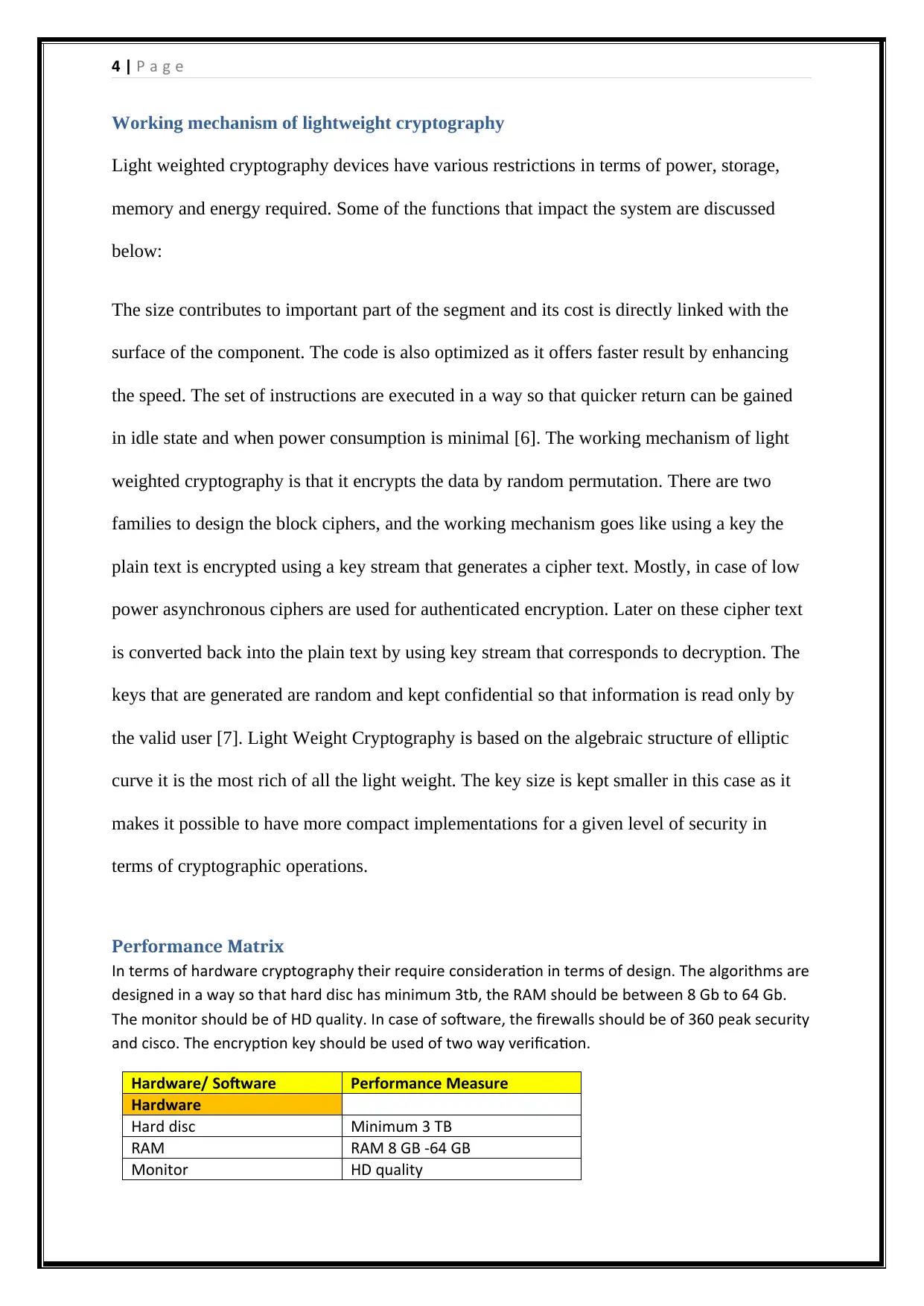
4 | P a g e
Working mechanism of lightweight cryptography
Light weighted cryptography devices have various restrictions in terms of power, storage,
memory and energy required. Some of the functions that impact the system are discussed
below:
The size contributes to important part of the segment and its cost is directly linked with the
surface of the component. The code is also optimized as it offers faster result by enhancing
the speed. The set of instructions are executed in a way so that quicker return can be gained
in idle state and when power consumption is minimal [6]. The working mechanism of light
weighted cryptography is that it encrypts the data by random permutation. There are two
families to design the block ciphers, and the working mechanism goes like using a key the
plain text is encrypted using a key stream that generates a cipher text. Mostly, in case of low
power asynchronous ciphers are used for authenticated encryption. Later on these cipher text
is converted back into the plain text by using key stream that corresponds to decryption. The
keys that are generated are random and kept confidential so that information is read only by
the valid user [7]. Light Weight Cryptography is based on the algebraic structure of elliptic
curve it is the most rich of all the light weight. The key size is kept smaller in this case as it
makes it possible to have more compact implementations for a given level of security in
terms of cryptographic operations.
Performance Matrix
In terms of hardware cryptography their require consideration in terms of design. The algorithms are
designed in a way so that hard disc has minimum 3tb, the RAM should be between 8 Gb to 64 Gb.
The monitor should be of HD quality. In case of software, the firewalls should be of 360 peak security
and cisco. The encryption key should be used of two way verification.
Hardware/ Software Performance Measure
Hardware
Hard disc Minimum 3 TB
RAM RAM 8 GB -64 GB
Monitor HD quality
Working mechanism of lightweight cryptography
Light weighted cryptography devices have various restrictions in terms of power, storage,
memory and energy required. Some of the functions that impact the system are discussed
below:
The size contributes to important part of the segment and its cost is directly linked with the
surface of the component. The code is also optimized as it offers faster result by enhancing
the speed. The set of instructions are executed in a way so that quicker return can be gained
in idle state and when power consumption is minimal [6]. The working mechanism of light
weighted cryptography is that it encrypts the data by random permutation. There are two
families to design the block ciphers, and the working mechanism goes like using a key the
plain text is encrypted using a key stream that generates a cipher text. Mostly, in case of low
power asynchronous ciphers are used for authenticated encryption. Later on these cipher text
is converted back into the plain text by using key stream that corresponds to decryption. The
keys that are generated are random and kept confidential so that information is read only by
the valid user [7]. Light Weight Cryptography is based on the algebraic structure of elliptic
curve it is the most rich of all the light weight. The key size is kept smaller in this case as it
makes it possible to have more compact implementations for a given level of security in
terms of cryptographic operations.
Performance Matrix
In terms of hardware cryptography their require consideration in terms of design. The algorithms are
designed in a way so that hard disc has minimum 3tb, the RAM should be between 8 Gb to 64 Gb.
The monitor should be of HD quality. In case of software, the firewalls should be of 360 peak security
and cisco. The encryption key should be used of two way verification.
Hardware/ Software Performance Measure
Hardware
Hard disc Minimum 3 TB
RAM RAM 8 GB -64 GB
Monitor HD quality
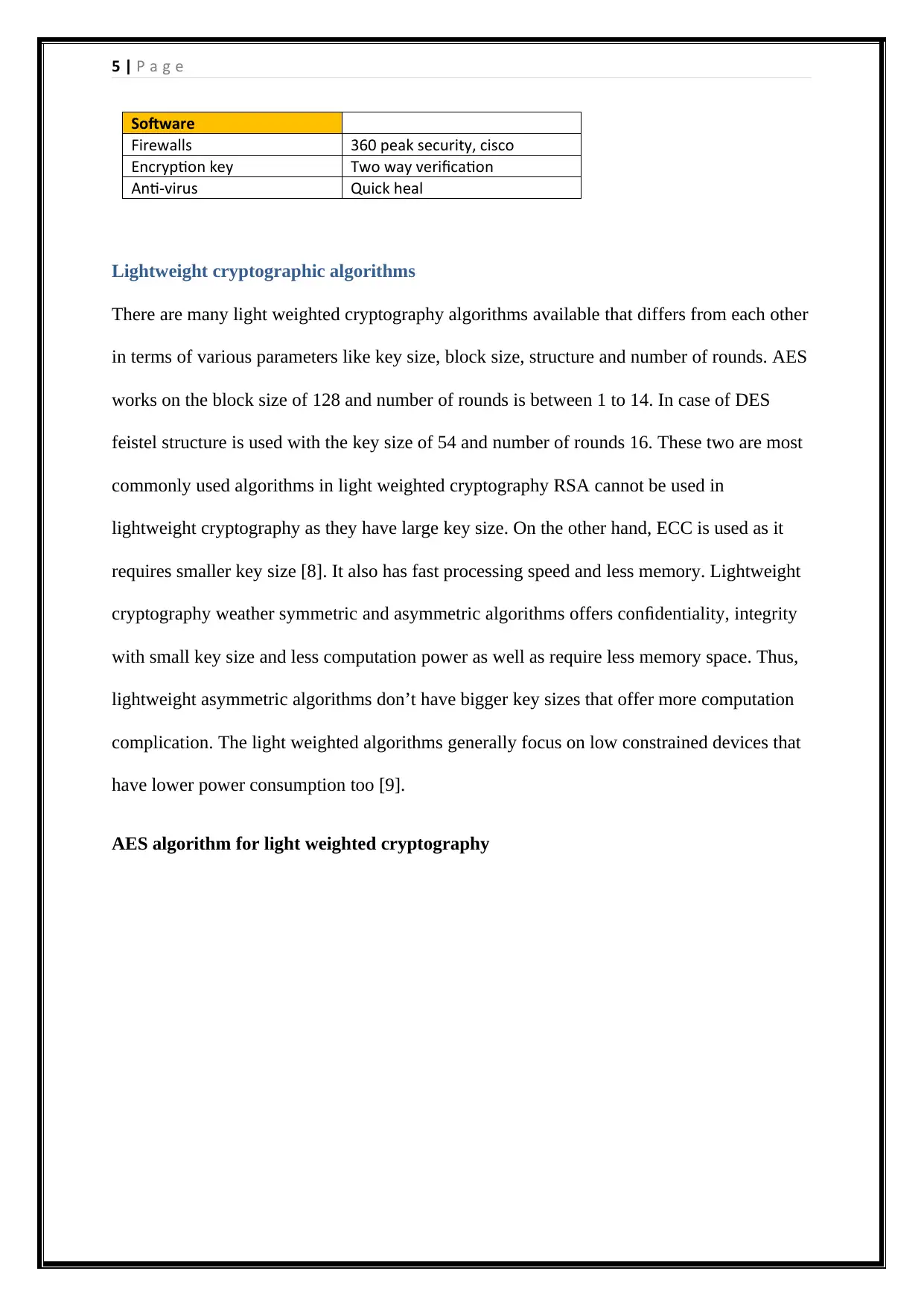
5 | P a g e
Software
Firewalls 360 peak security, cisco
Encryption key Two way verification
Anti-virus Quick heal
Lightweight cryptographic algorithms
There are many light weighted cryptography algorithms available that differs from each other
in terms of various parameters like key size, block size, structure and number of rounds. AES
works on the block size of 128 and number of rounds is between 1 to 14. In case of DES
feistel structure is used with the key size of 54 and number of rounds 16. These two are most
commonly used algorithms in light weighted cryptography RSA cannot be used in
lightweight cryptography as they have large key size. On the other hand, ECC is used as it
requires smaller key size [8]. It also has fast processing speed and less memory. Lightweight
cryptography weather symmetric and asymmetric algorithms offers confidentiality, integrity
with small key size and less computation power as well as require less memory space. Thus,
lightweight asymmetric algorithms don’t have bigger key sizes that offer more computation
complication. The light weighted algorithms generally focus on low constrained devices that
have lower power consumption too [9].
AES algorithm for light weighted cryptography
Software
Firewalls 360 peak security, cisco
Encryption key Two way verification
Anti-virus Quick heal
Lightweight cryptographic algorithms
There are many light weighted cryptography algorithms available that differs from each other
in terms of various parameters like key size, block size, structure and number of rounds. AES
works on the block size of 128 and number of rounds is between 1 to 14. In case of DES
feistel structure is used with the key size of 54 and number of rounds 16. These two are most
commonly used algorithms in light weighted cryptography RSA cannot be used in
lightweight cryptography as they have large key size. On the other hand, ECC is used as it
requires smaller key size [8]. It also has fast processing speed and less memory. Lightweight
cryptography weather symmetric and asymmetric algorithms offers confidentiality, integrity
with small key size and less computation power as well as require less memory space. Thus,
lightweight asymmetric algorithms don’t have bigger key sizes that offer more computation
complication. The light weighted algorithms generally focus on low constrained devices that
have lower power consumption too [9].
AES algorithm for light weighted cryptography
⊘ This is a preview!⊘
Do you want full access?
Subscribe today to unlock all pages.

Trusted by 1+ million students worldwide
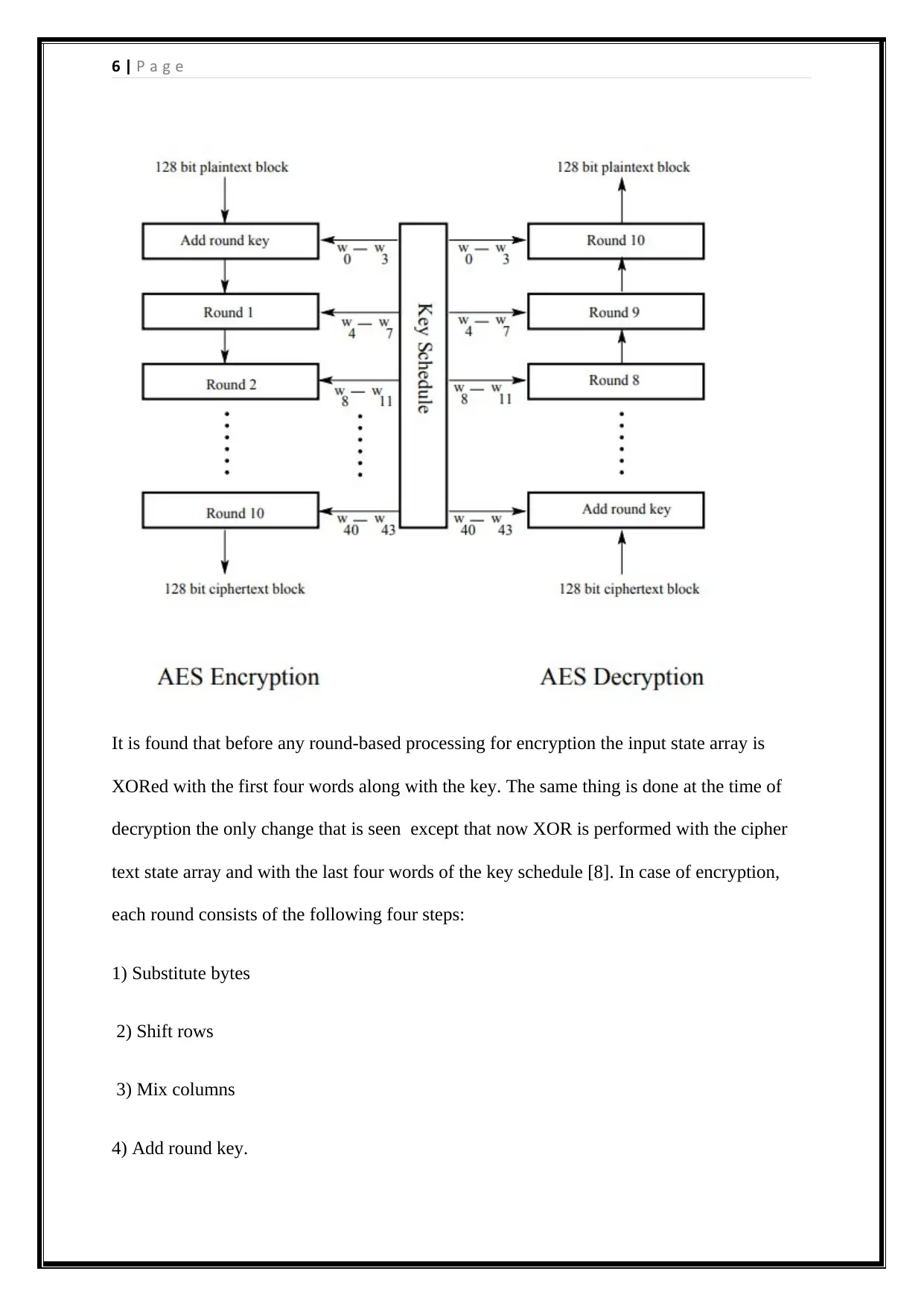
6 | P a g e
It is found that before any round-based processing for encryption the input state array is
XORed with the first four words along with the key. The same thing is done at the time of
decryption the only change that is seen except that now XOR is performed with the cipher
text state array and with the last four words of the key schedule [8]. In case of encryption,
each round consists of the following four steps:
1) Substitute bytes
2) Shift rows
3) Mix columns
4) Add round key.
It is found that before any round-based processing for encryption the input state array is
XORed with the first four words along with the key. The same thing is done at the time of
decryption the only change that is seen except that now XOR is performed with the cipher
text state array and with the last four words of the key schedule [8]. In case of encryption,
each round consists of the following four steps:
1) Substitute bytes
2) Shift rows
3) Mix columns
4) Add round key.
Paraphrase This Document
Need a fresh take? Get an instant paraphrase of this document with our AI Paraphraser
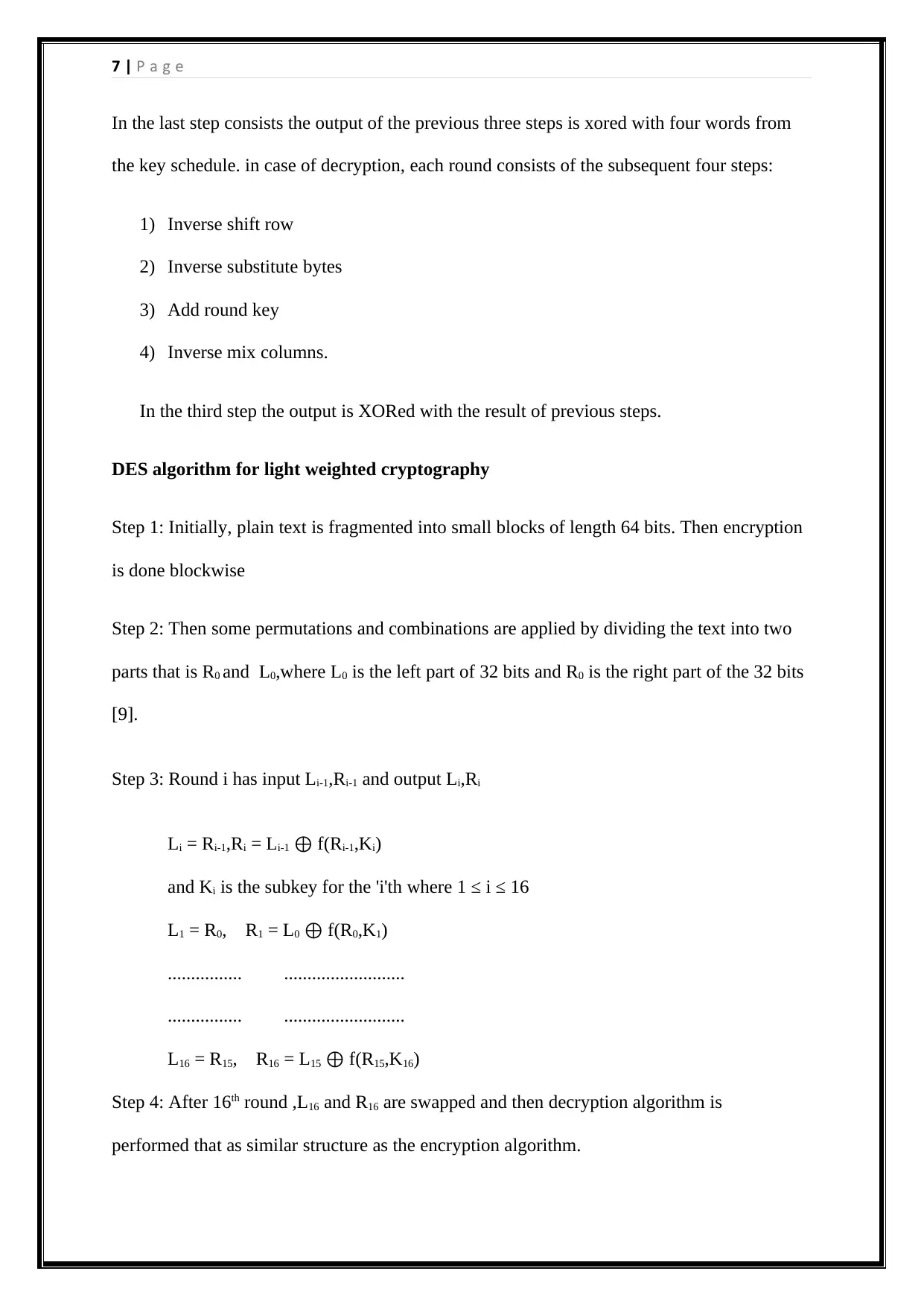
7 | P a g e
In the last step consists the output of the previous three steps is xored with four words from
the key schedule. in case of decryption, each round consists of the subsequent four steps:
1) Inverse shift row
2) Inverse substitute bytes
3) Add round key
4) Inverse mix columns.
In the third step the output is XORed with the result of previous steps.
DES algorithm for light weighted cryptography
Step 1: Initially, plain text is fragmented into small blocks of length 64 bits. Then encryption
is done blockwise
Step 2: Then some permutations and combinations are applied by dividing the text into two
parts that is R0 and L0,where L0 is the left part of 32 bits and R0 is the right part of the 32 bits
[9].
Step 3: Round i has input Li-1,Ri-1 and output Li,Ri
Li = Ri-1,Ri = Li-1 ⊕ f(Ri-1,Ki)
and Ki is the subkey for the 'i'th where 1 ≤ i ≤ 16
L1 = R0, R1 = L0 ⊕ f(R0,K1)
................ ..........................
................ ..........................
L16 = R15, R16 = L15 ⊕ f(R15,K16)
Step 4: After 16th round ,L16 and R16 are swapped and then decryption algorithm is
performed that as similar structure as the encryption algorithm.
In the last step consists the output of the previous three steps is xored with four words from
the key schedule. in case of decryption, each round consists of the subsequent four steps:
1) Inverse shift row
2) Inverse substitute bytes
3) Add round key
4) Inverse mix columns.
In the third step the output is XORed with the result of previous steps.
DES algorithm for light weighted cryptography
Step 1: Initially, plain text is fragmented into small blocks of length 64 bits. Then encryption
is done blockwise
Step 2: Then some permutations and combinations are applied by dividing the text into two
parts that is R0 and L0,where L0 is the left part of 32 bits and R0 is the right part of the 32 bits
[9].
Step 3: Round i has input Li-1,Ri-1 and output Li,Ri
Li = Ri-1,Ri = Li-1 ⊕ f(Ri-1,Ki)
and Ki is the subkey for the 'i'th where 1 ≤ i ≤ 16
L1 = R0, R1 = L0 ⊕ f(R0,K1)
................ ..........................
................ ..........................
L16 = R15, R16 = L15 ⊕ f(R15,K16)
Step 4: After 16th round ,L16 and R16 are swapped and then decryption algorithm is
performed that as similar structure as the encryption algorithm.
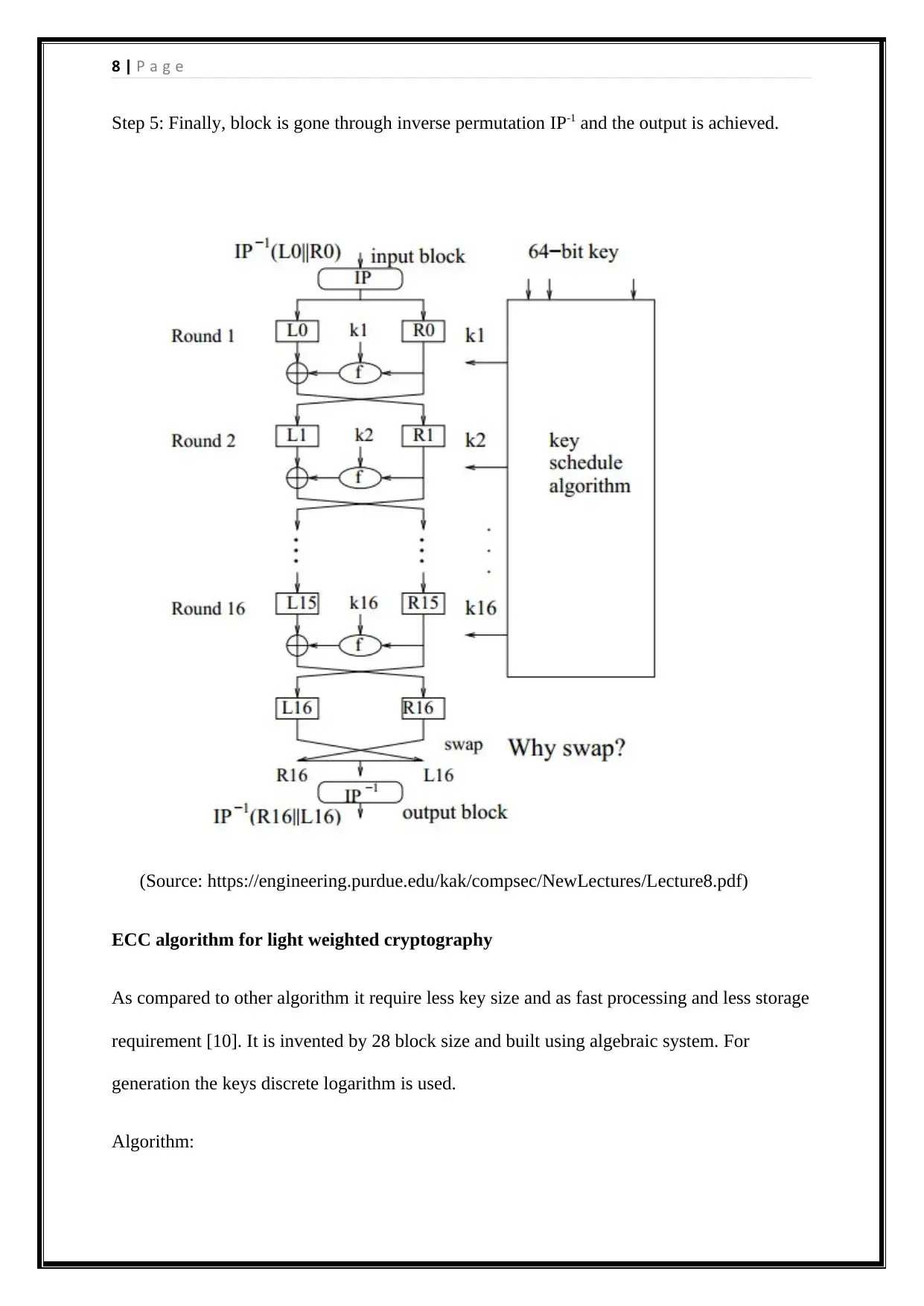
8 | P a g e
Step 5: Finally, block is gone through inverse permutation IP-1 and the output is achieved.
(Source: https://engineering.purdue.edu/kak/compsec/NewLectures/Lecture8.pdf)
ECC algorithm for light weighted cryptography
As compared to other algorithm it require less key size and as fast processing and less storage
requirement [10]. It is invented by 28 block size and built using algebraic system. For
generation the keys discrete logarithm is used.
Algorithm:
Step 5: Finally, block is gone through inverse permutation IP-1 and the output is achieved.
(Source: https://engineering.purdue.edu/kak/compsec/NewLectures/Lecture8.pdf)
ECC algorithm for light weighted cryptography
As compared to other algorithm it require less key size and as fast processing and less storage
requirement [10]. It is invented by 28 block size and built using algebraic system. For
generation the keys discrete logarithm is used.
Algorithm:
⊘ This is a preview!⊘
Do you want full access?
Subscribe today to unlock all pages.

Trusted by 1+ million students worldwide
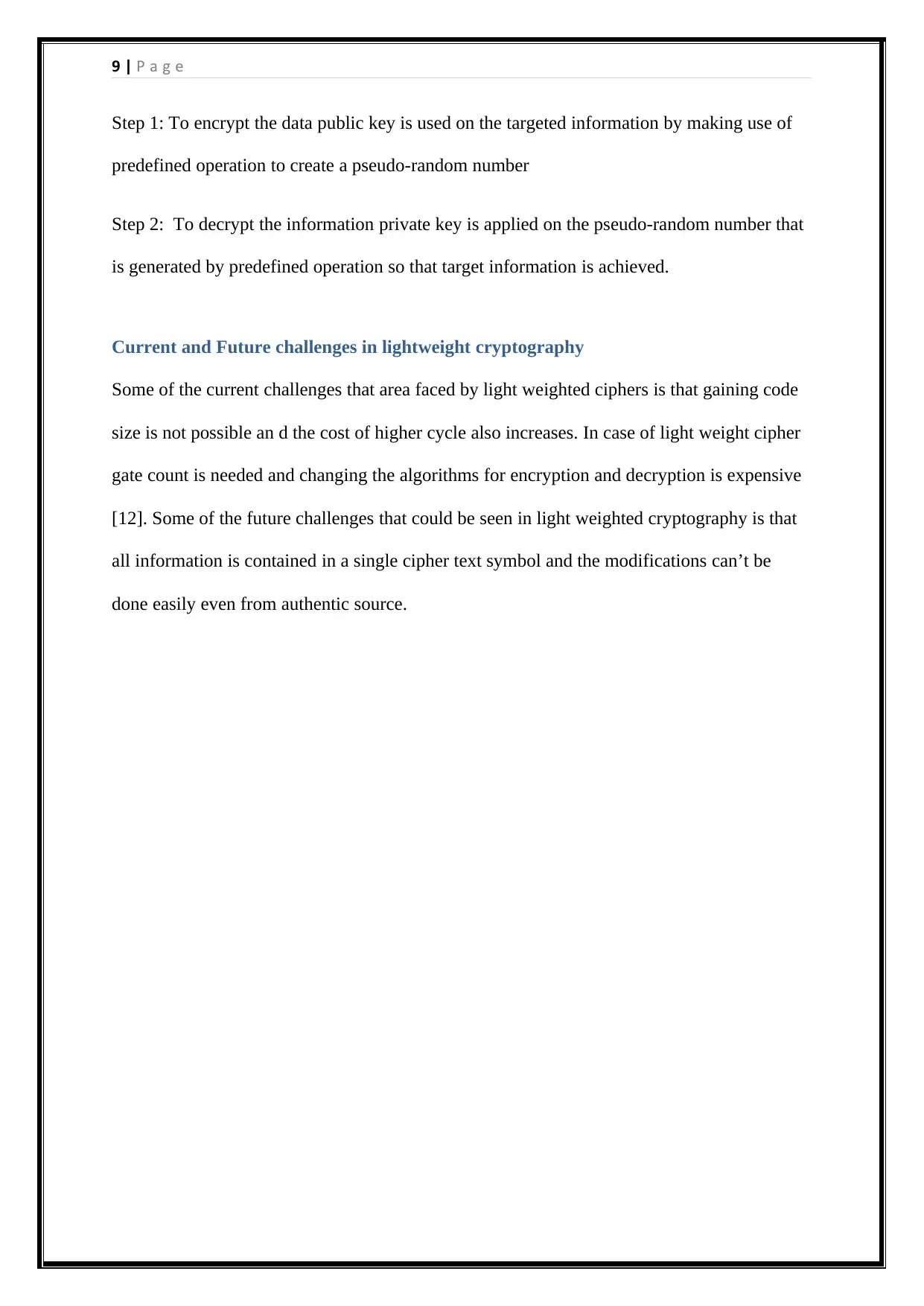
9 | P a g e
Step 1: To encrypt the data public key is used on the targeted information by making use of
predefined operation to create a pseudo-random number
Step 2: To decrypt the information private key is applied on the pseudo-random number that
is generated by predefined operation so that target information is achieved.
Current and Future challenges in lightweight cryptography
Some of the current challenges that area faced by light weighted ciphers is that gaining code
size is not possible an d the cost of higher cycle also increases. In case of light weight cipher
gate count is needed and changing the algorithms for encryption and decryption is expensive
[12]. Some of the future challenges that could be seen in light weighted cryptography is that
all information is contained in a single cipher text symbol and the modifications can’t be
done easily even from authentic source.
Step 1: To encrypt the data public key is used on the targeted information by making use of
predefined operation to create a pseudo-random number
Step 2: To decrypt the information private key is applied on the pseudo-random number that
is generated by predefined operation so that target information is achieved.
Current and Future challenges in lightweight cryptography
Some of the current challenges that area faced by light weighted ciphers is that gaining code
size is not possible an d the cost of higher cycle also increases. In case of light weight cipher
gate count is needed and changing the algorithms for encryption and decryption is expensive
[12]. Some of the future challenges that could be seen in light weighted cryptography is that
all information is contained in a single cipher text symbol and the modifications can’t be
done easily even from authentic source.
Paraphrase This Document
Need a fresh take? Get an instant paraphrase of this document with our AI Paraphraser
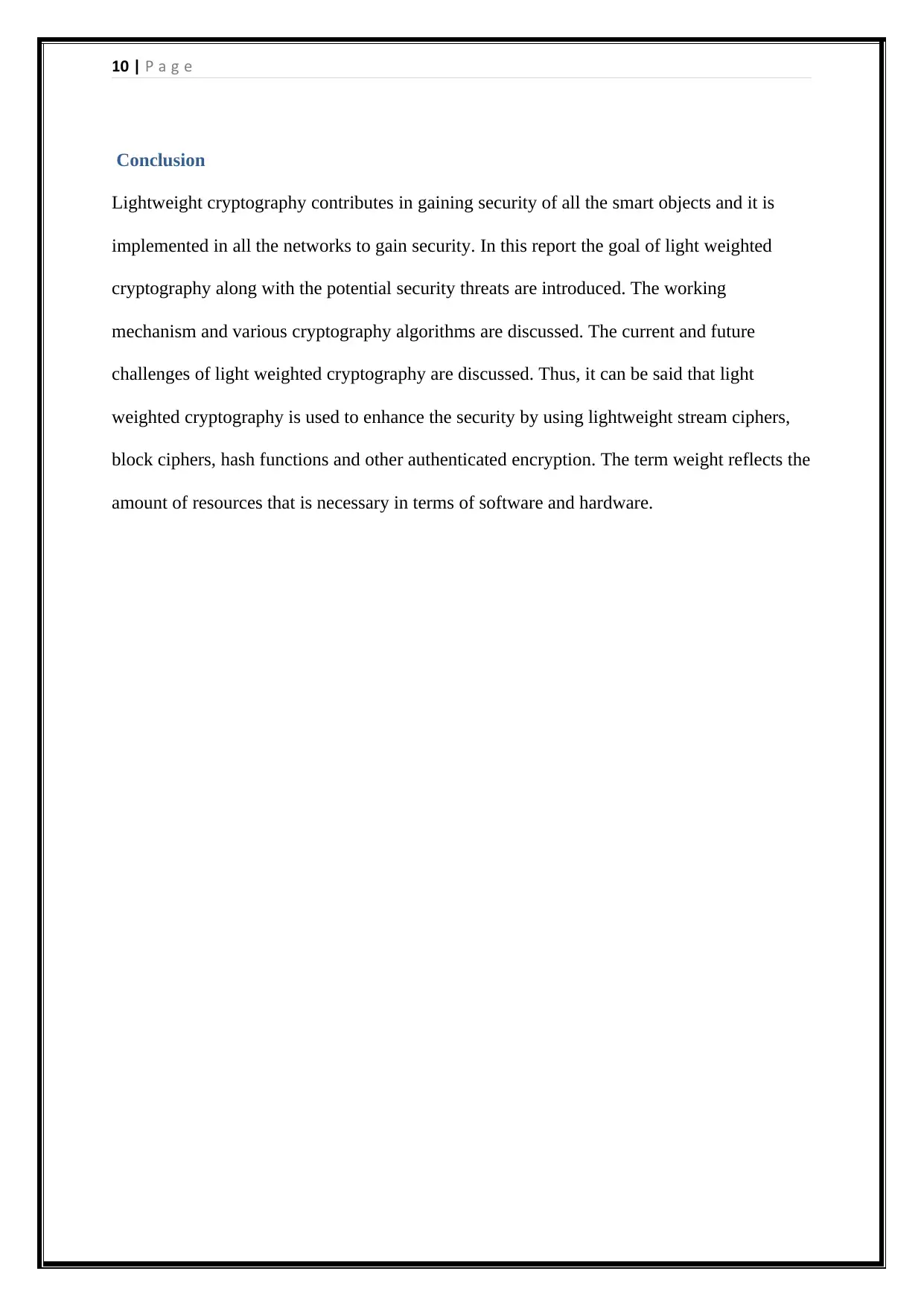
10 | P a g e
Conclusion
Lightweight cryptography contributes in gaining security of all the smart objects and it is
implemented in all the networks to gain security. In this report the goal of light weighted
cryptography along with the potential security threats are introduced. The working
mechanism and various cryptography algorithms are discussed. The current and future
challenges of light weighted cryptography are discussed. Thus, it can be said that light
weighted cryptography is used to enhance the security by using lightweight stream ciphers,
block ciphers, hash functions and other authenticated encryption. The term weight reflects the
amount of resources that is necessary in terms of software and hardware.
Conclusion
Lightweight cryptography contributes in gaining security of all the smart objects and it is
implemented in all the networks to gain security. In this report the goal of light weighted
cryptography along with the potential security threats are introduced. The working
mechanism and various cryptography algorithms are discussed. The current and future
challenges of light weighted cryptography are discussed. Thus, it can be said that light
weighted cryptography is used to enhance the security by using lightweight stream ciphers,
block ciphers, hash functions and other authenticated encryption. The term weight reflects the
amount of resources that is necessary in terms of software and hardware.
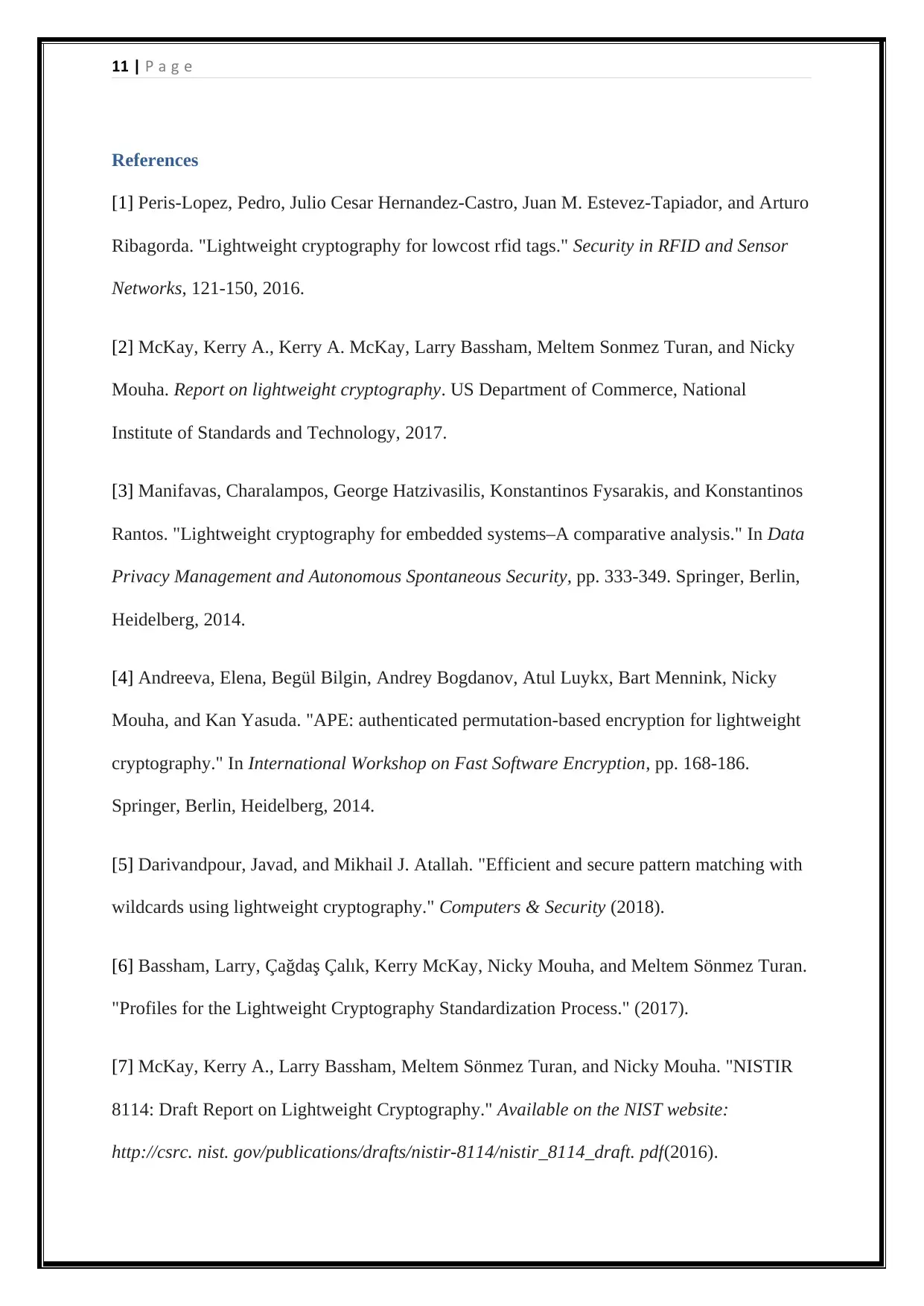
11 | P a g e
References
[1] Peris-Lopez, Pedro, Julio Cesar Hernandez-Castro, Juan M. Estevez-Tapiador, and Arturo
Ribagorda. "Lightweight cryptography for lowcost rfid tags." Security in RFID and Sensor
Networks, 121-150, 2016.
[2] McKay, Kerry A., Kerry A. McKay, Larry Bassham, Meltem Sonmez Turan, and Nicky
Mouha. Report on lightweight cryptography. US Department of Commerce, National
Institute of Standards and Technology, 2017.
[3] Manifavas, Charalampos, George Hatzivasilis, Konstantinos Fysarakis, and Konstantinos
Rantos. "Lightweight cryptography for embedded systems–A comparative analysis." In Data
Privacy Management and Autonomous Spontaneous Security, pp. 333-349. Springer, Berlin,
Heidelberg, 2014.
[4] Andreeva, Elena, Begül Bilgin, Andrey Bogdanov, Atul Luykx, Bart Mennink, Nicky
Mouha, and Kan Yasuda. "APE: authenticated permutation-based encryption for lightweight
cryptography." In International Workshop on Fast Software Encryption, pp. 168-186.
Springer, Berlin, Heidelberg, 2014.
[5] Darivandpour, Javad, and Mikhail J. Atallah. "Efficient and secure pattern matching with
wildcards using lightweight cryptography." Computers & Security (2018).
[6] Bassham, Larry, Çağdaş Çalık, Kerry McKay, Nicky Mouha, and Meltem Sönmez Turan.
"Profiles for the Lightweight Cryptography Standardization Process." (2017).
[7] McKay, Kerry A., Larry Bassham, Meltem Sönmez Turan, and Nicky Mouha. "NISTIR
8114: Draft Report on Lightweight Cryptography." Available on the NIST website:
http://csrc. nist. gov/publications/drafts/nistir-8114/nistir_8114_draft. pdf(2016).
References
[1] Peris-Lopez, Pedro, Julio Cesar Hernandez-Castro, Juan M. Estevez-Tapiador, and Arturo
Ribagorda. "Lightweight cryptography for lowcost rfid tags." Security in RFID and Sensor
Networks, 121-150, 2016.
[2] McKay, Kerry A., Kerry A. McKay, Larry Bassham, Meltem Sonmez Turan, and Nicky
Mouha. Report on lightweight cryptography. US Department of Commerce, National
Institute of Standards and Technology, 2017.
[3] Manifavas, Charalampos, George Hatzivasilis, Konstantinos Fysarakis, and Konstantinos
Rantos. "Lightweight cryptography for embedded systems–A comparative analysis." In Data
Privacy Management and Autonomous Spontaneous Security, pp. 333-349. Springer, Berlin,
Heidelberg, 2014.
[4] Andreeva, Elena, Begül Bilgin, Andrey Bogdanov, Atul Luykx, Bart Mennink, Nicky
Mouha, and Kan Yasuda. "APE: authenticated permutation-based encryption for lightweight
cryptography." In International Workshop on Fast Software Encryption, pp. 168-186.
Springer, Berlin, Heidelberg, 2014.
[5] Darivandpour, Javad, and Mikhail J. Atallah. "Efficient and secure pattern matching with
wildcards using lightweight cryptography." Computers & Security (2018).
[6] Bassham, Larry, Çağdaş Çalık, Kerry McKay, Nicky Mouha, and Meltem Sönmez Turan.
"Profiles for the Lightweight Cryptography Standardization Process." (2017).
[7] McKay, Kerry A., Larry Bassham, Meltem Sönmez Turan, and Nicky Mouha. "NISTIR
8114: Draft Report on Lightweight Cryptography." Available on the NIST website:
http://csrc. nist. gov/publications/drafts/nistir-8114/nistir_8114_draft. pdf(2016).
⊘ This is a preview!⊘
Do you want full access?
Subscribe today to unlock all pages.

Trusted by 1+ million students worldwide
1 out of 13
Related Documents
Your All-in-One AI-Powered Toolkit for Academic Success.
+13062052269
info@desklib.com
Available 24*7 on WhatsApp / Email
![[object Object]](/_next/static/media/star-bottom.7253800d.svg)
Unlock your academic potential
Copyright © 2020–2025 A2Z Services. All Rights Reserved. Developed and managed by ZUCOL.





